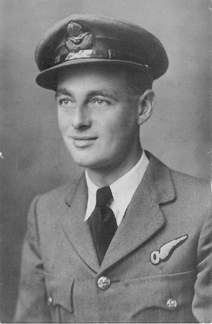 |
 |
||
|
Pilot Officer Nav B/W John Carruthers 1035099 RAFVR John Carruthers joined the RAF in 1942. He went to India in that rather shambolic mid-1943 period of rebuilding. Caught up in the delays that affected the three freshly forming Beaufighter Squadrons (Nos 176, 177 and 211), he finally joined 211 Squadron just after they resumed operational status in January 1944. He was to remain with them until April 1945, tour expired, a very considerable achievement.
Navigator training Posted to RAF Squires Gate and 3 School of General Reconnaissance in December 1942, with another 19 Anson hours accumulated in the log over the eight weeks of GR course 7.W, his efforts earned him high RAF praise on completion: an "above average" rating as a Navigator. Transit to India On 3 June 1943 he and Lowcock were off, a short leg to Portreath, then the long hours to Ras El Ma, and again to Castel Benito, followed quickly by El Adem, Cairo West, Aquir, Habbaniya, Shaibah, Bahrein, Sharjah and at last Karachi, some 33 hours in the air in 8 days. Hurry up and wait As a result, a number of the 211s spent time kicking around other postings. In the case of the pilots, (like EL Wood, for example) some effort was apparently made to find posts selected to keep their flying currency up. However, in the case of the Navigators like Carruthers and Ivan Gilmore, this may not have been the case. Certainly for F/Sgt Carruthers, a six month gap occurs in his list of Navigator postings and in his flying hours. It was December 1943 before he and Lowcock flew together again, on what is pretty clearly a short (2 week) Blenheim & Beaufighter refresher course. 211 Squadron... On 12 April 1944 John Carruthers flew on his first operation, now crewing with S/Ldr Thomson, OC ‘A’ Flight. It was a busy time and with Thomson in the “office”, they completed 6 sorties safely by the end of the month. A break in Ceylon for the General Reconnaissance and Air Navigation School’s Ship Recognition Course and a quiet patch were followed by a busy July, this time regularly crewed with W/O Vaughan, before another SLAIS course as Nav/W to F/Lt McKnight. In September, though bound for Chittagong hospital apparently ill, he navigated the flight for F/O EL Wood in the cockpit (though their logs differ as to detail). Returned from hospital, a spot of leave followed. Then Carruthers was off to Calcutta to kit out for his commissioning, gazetted as a Pilot Officer in the London Gazette No 36780 of 7 November, with effect from 21 July. He was in good company: George Manderson was commissioned on the same date. P/O Carruthers now had over 330 hours in the Log Book, and over a dozen operations to his credit. From October 1944 onwards, he was on operations more or less continuously as regular Navigator to Stacey, the Australian, who rose steadily from F/O to command ‘B’ Flight as F/Lt and later S/Ldr. In a year of 211 Squadron operations, P/O Carruthers completed his tour with 42 sorties in 188:30 flying hours, out of his total flying time of some 508 hours. Quite an achievement. His original Pilot, Lowcock, was not so fortunate, dying in a flying accident in June 1945. ...and afterwards In late 2005 his son Philip Carruthers in Brazil came across the 211 Squadron website. He made contact, kindly offering a copy of his late father’s Log Book and the happy formal portrait seen above. This narrative has been compiled mainly from John Carruthers Log Book, the Squadron Operations Record Book, and the London Gazette. Sources
www.211squadron.org © D Clark & others 1998—2025 |
||
